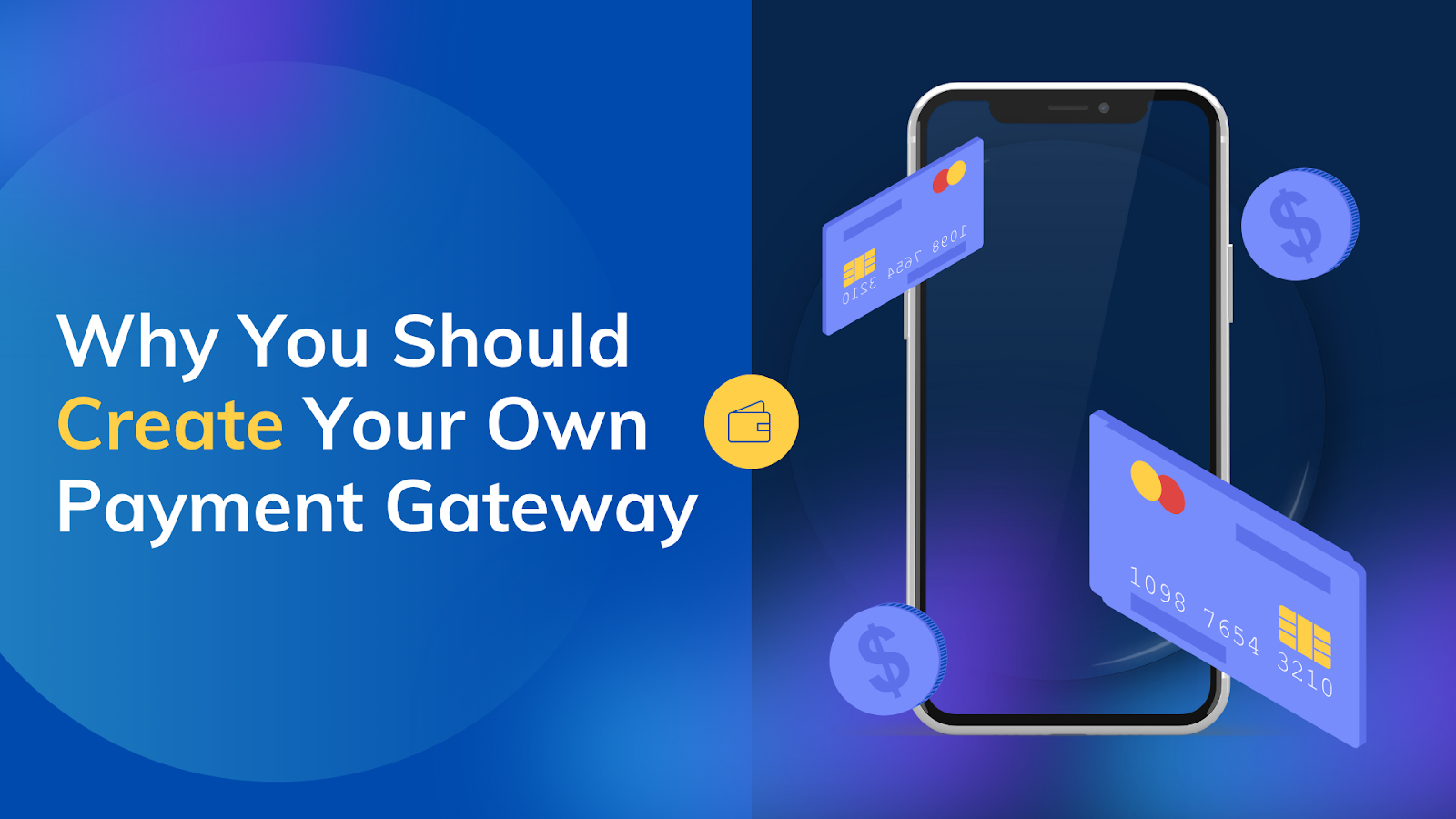Table of Contents:
- 1. Own payment gateway
- 2. Custom payment gateway
- 3. Build your own payment gateway
- 4. Benefits of own payment gateway
- 5. Why create your own payment gateway
Your customer’s shopping experience has transformed with the intervention of the internet and artificial intelligence. These technological advancements have eliminated the hassle to move out and shop, easing the shopping process.
It is possible because e-commerce shops allow customers to browse, select, finalize, and even make payments online. Yes, businesses allow customers to now clear their custom payment gateway through their stores built with the latest e-commerce development standards.
Integrating your e-shop with a payment gateway helps you gain credibility from your customers by offering them a secure and smooth payment process. Thus, businesses need to incorporate a payment gateway.
In this blog, we will discuss what a payment gateway is, why you should create a payment gateway, the drawbacks of third-party payment gateways, and more. Let’s dive in!
What are Payment Gateways?
A payment gateway is a software used to provide internet handling for its payment transactions between customers and merchants. It acts as a digital bridge taking up payment particulars from a buyer, encrypting this information, and later authorizing the transaction through the issuing bank or any financial institution.
Whenever the customer visits an e-commerce website for checkout, the payment gateway does its work of checking the card details, confirming whether enough funds are available, and completing the transaction with safety and speed in the span of a few seconds, most times, without even the user being aware of it.
Because of that, it has become the most important thing, enabling cashless transactions, even in today's world, top-most of online conveniences. The most well-known third-party gateways would be PayPal, Stripe, Square, Razorpay, and Authorize.Net. These services have come up with prebuilt solutions that can easily be integrated; hence, they are well for all start-ups and small to mid-sized businesses that are looking to embrace online payments with the least possible hassles.
Why Businesses Traditionally Use Third-Party Payment Gateways :
Since third-party applications are already authorized and registered payment gateways, it is easy for businesses to integrate them. Here are some other reasons why businesses use third-party payment gateways instead of building their own payment gateway.
1. Easy Money Processing :
Payment gateways simplify payment processes for businesses by managing the complexities of transactions. This allows companies to accept various payment methods, such as credit cards and digital wallets, without needing extensive technical knowledge.
2. National Security :
These gateways protect customer data from fraud and breaches using encryption and secure protocols while incorporating fraud detection to stop suspicious transactions.
3. Affordability and Cost Reduction :
Maintaining merchant accounts is expensive, but gateways offer affordable solutions for small businesses.
4. Easy Checkout :
Payment gateways enhance customer experience by facilitating faster, automated transactions, resulting in quicker sales and improved cash flow.
5. Globalization and Localization :
They support multiple currencies, enabling businesses to accept local and international payments, enhancing buyer satisfaction in new markets.
6. Accelerated Funds Transfer Cycle :
Third-party processors often provide quicker access to funds, benefiting businesses with faster cash flow.
The Hidden Drawbacks of Third-Party Payment Gateways
Although third-party payment gateways come with enough convenience and are easy to integrate into various systems, they come with many hidden costs that might adversely affect a business’s bottom line and operational flexibility, especially in terms of scale.
1. High Transaction Fees & Service Charges
The greatest concern with these gateways remains transaction fees, which hurt profit. The more transactions, the less profit, especially for high-volume businesses on very low margins. So, expense-wise, that becomes quite a burden over time.
2. Lack of Control Over User Experience
Businesses rarely have much room for customization for checkout design, branding, and user flow, with third-party gateways a surefire way to create a solid customer journey resulting in reduced conversion rates.
3. Account Hold or Freeze
Account holds or freezes are also possible with excessive transaction blocks or changes in risk policies, which could disrupt cash flow with no prior warning. Besides, external vendor partnerships create a form of operational dependence by handing over a critical part of your business to someone else.
4. Rigidity Towards Unique Business Models
There may be other unconventional or evolving business models that might not be supported by these gateways, restricting any innovating opportunity that yields growth in terms of hybrid subscriptions, microtransactions, or multi-vendor marketplaces.
Why Create Your Own Payment Gateway
Creating your own e-commerce payment gateway is a big move. However, for scaling businesses trying to lower operational costs and provide amazing customer service, the investment can prove to be a game-changer. Here are some key reasons why setting up an in-house payment infrastructure can have long-term strategic benefits:
a. Cost Savings in the Long Run
Substantial long-term savings tend to be a huge incentive for putting together an in-house payment gateway, as it is one of the biggest factors that influence such a decision. While a best-perceived short-run solution from the perspective of integrating third-party payment processors like Stripe or PayPal into their business may potentially work, their transaction fees become quite a hefty tax, especially for businesses with high-volume revenue.
Here is a simple illustration: Suppose you have $500,000 in monthly transactions; applying a 2.9% fee from your gateway gives you $14,500 in fees per month and $174,000 in fees annually. Multiply that by several years for a figure in seven digits.
Thus, while the own alternative maintains high overheads for building your ecommerce payment gateway, it can bring about a preferred outcome with marginal or no recurring fees. Once the gateway is up and running, it allows the business firm to retain most of its revenue. Therefore, it provides a much cheaper way of going after business in the long run. Such transformation allows higher margins of profits, liberating some of the revenues for innovation and growth.
b. Full Control Over the Payment Process
You now have unrestricted hold and control over each phase of the transaction process, without paying attention to the checkout page's design or any functional area intended to drive conversions. Third-party gateways impose rigid UI/UX templating and branding limitations. Whereas, your exclusive gateway allows you to create a frictionless experience fully aligned with your brand.
Custom features can range from discount codes to cashback reward status, loyalty status, and multi-currency support, catering to your customers. You are fully allowed to test and optimize the user journey for more engagement and decreased cart abandonment.
This very control gives you possible access to creating an extraordinarily fast and secure checkout process that speaks volumes about your business model and meets the expectations of your customers.
c. Enhanced Security and Compliance
When it comes to handling financial transactions, security is non-negotiable. Since you're having a payment gateway built on your terms, you can have custom security protocols set in place, tailor-made for your business, instead of a one-size-fits-all solution.
You can develop a system compliant with PCI DSS (Payment Card Industry Data Security Standard) in whatever combination is suitable for your internal infrastructure. More control can then be gained over data encryption, tokenization, and secure storage, thereby minimizing the risk of breaches and unauthorized access.
Furthermore, building an in-house gateway allows you to build fraud detection and prevention mechanisms tailored to your industry and customer base. Whether that involves machine learning algorithms, velocity checks, or real-time transaction tracking, the ball is in your court. With the increase in cybercrime and data breaches, having full control of your payment infrastructure will hugely increase protection for your business and its customers.
d. Much Better Customer Experience
As far as online payments are concerned, the purchasing process could make or break a sale. A simple, logical, and fast payment process translates directly into increased conversion and increased customer satisfaction.
With your own payment gateway, you're getting rid of unnecessary redirects and external pages, thus providing a seamless experience that keeps users within your brand ecosystem. This builds trust and reduces drop-offs during checkout.
Additionally, you may offer tailored payment options depending on user history or preferences and support local currencies and payment methods while integrating alternative options such as buy-now-pay-later services. This creates a user-friendly, custom-tailored payment process that strengthens your competitive position for customer retention.
e. Easier Integration into the Business Systems
An efficiently run business means all internal systems- sales, CRM, accounting, and inventory- have to work smoothly together. Clearly, with your proprietary gateway, you can seamlessly integrate your e-payment processing with the internal systems and avoid manual reconciliations or issues with third-party fixes.
This will allow real-time data syncing, faster financial reporting, and a smoother customer service process. The level of integration demonstrated here would provide huge time savings and improved operational visibility for businesses handling high transaction volumes or complex sales flows such as subscriptions or multivendor environments.
f. Competitive Advantage
Creating your payment gateway isn't merely saving costs or improving operations -- it is strategic differentiation. This gives your business its unique selling proposition: a fast, secure, branded, and reliable payment process that distinguishes you from competitors relying on third-party tools
Especially powerful for marketplaces, SaaS platforms, fintech firms, and e-commerce enterprises of all scales, which want to own the entire user journey and financial infrastructure. In industries where customer trust and experience become paramount, your payment gateway can be a core asset driving loyalty, innovation, and long-term growth.
Challenges of Creating a Payment Gateway
The highly beneficial building of a payment gateway on its own poses several challenges that ought to be considered carefully before a company goes into their construction.
1. High Startup Cost of Development & Maintenance
Setting up a secure, scalable, and reliable payment infrastructure should justify its name only after investing in temporary infrastructure in terms of software engineering, setting up infrastructures, and even keeping track of regulatory requirements. This is not a one-off cost since, afterward, further on, continuous feature enhancement and server management will always call for both financial and technical resources.
2. Compliance with Regulatory Standards
Compliance with various regulatory standards such as PCI DSS for card data security and GDPR for data privacy, assuming you have a European angle. These frameworks are complex; therefore, development may take time while costing extra
3. Security Standards
You will also have to run security audits regularly and upgrade constantly to resolve security vulnerabilities while having a very agile mechanism against evolving cyber threats in place. You must also establish operational processes and customer support toward the management of dispute resolution and chargebacks.
4. High-Skilled Developers
The maintenance and construction of the gateway require a skilled workforce: backend guru developers, cybersecurity experts, and compliance officers, and have therefore highly drained the available resources for survival on the part of companies with a long-term view, well prepared with technical infrastructure.
When Does it Make Sense to Build Your Own Payment Gateway?
While it may not be necessary for every business to build its own payment gateway, for the right kind of organization, it's a smart strategic move. If your business is processing high volumes of transactions, then the fees from third-party gateways could soon prove unsustainable, in which case a proprietary solution would become more amenable over time.
Several businesses have very special requirements: the multi-vendor marketplace, subscription-oriented platforms with complicated payment options, and microtransaction suppliers. In these instances, a high level of flexibility and customization is often required, which off-the-shelf solutions are unable to provide.
On those same lines, should your operation require deep integration with internal systems like CRMs, ERPs, or custom analytics platforms, payment infrastructure ownership eases connectivity and increases efficiency.
Most importantly, if a highly personalized user experience is paramount for your business or if you have a long development horizon with adequate resources for secure infrastructure investment, an in-house payment gateway could significantly aid the scaling effort, allow for control over the gateway, and provide competitive differentiation.
Conclusion
Building your own payment gateway system is a big task, but it can bring great benefits to businesses with the right size, vision, and technical skills. From ongoing cost savings to enhanced security and improved customer experience, all-in-one third-party solutions are great for starting. However, it always falls through when companies expand and diversify. Owning your payment infrastructure puts you in the driver's seat, empowering you to innovate and scale with confidence. Building your own payment gateway is probably one of the best decisions you'd make if you're future-oriented and plan on owning a larger part of your value chain.
If you want to build your own payment gateway for your business, contact BestPeers Our team of experienced developers and UI/UX designers will create a seamless one for your business. Take the first-mover advantage and contact us now!




